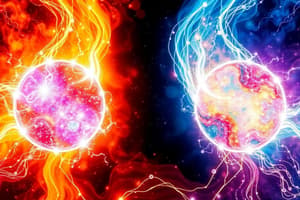Podcast
Questions and Answers
In the context of chemical reactions, what does the term "redox" refer to?
In the context of chemical reactions, what does the term "redox" refer to?
Redox is a shortened form of "reduction-oxidation", representing chemical reactions where both oxidation and reduction occur simultaneously.
Which of the following is NOT a classical example of an oxidation reaction, based on the original definition?
Which of the following is NOT a classical example of an oxidation reaction, based on the original definition?
- 2 H2S(g) + O2 (g) → 2 S (s) + 2 H2O (l) (correct)
- CH4 (g) + 2O2 (g) → CO2 (g) + 2H2O (l)
- 2Mg (s) + O2 (g) → 2MgO (s)
- S (s) + O2 (g) → SO2 (g)
What is the primary difference between the classical definition of oxidation and the more modern electron-transfer definition?
What is the primary difference between the classical definition of oxidation and the more modern electron-transfer definition?
The classical definition focused on the addition of oxygen or removal of hydrogen. The electron-transfer definition focuses on the loss or gain of electrons during a reaction.
In the reaction represented by the equation: 2Na(s) + Cl2(g) → 2NaCl(s), which species is being oxidized?
In the reaction represented by the equation: 2Na(s) + Cl2(g) → 2NaCl(s), which species is being oxidized?
Which of the following statements accurately describes the electron transfer occurring in a reduction reaction?
Which of the following statements accurately describes the electron transfer occurring in a reduction reaction?
The term "oxidation" can ONLY be applied to reactions involving oxygen.
The term "oxidation" can ONLY be applied to reactions involving oxygen.
In the reaction: Zn(s) + Cu²+(aq) → Zn²+(aq) + Cu(s), which metal is acting as an oxidising agent?
In the reaction: Zn(s) + Cu²+(aq) → Zn²+(aq) + Cu(s), which metal is acting as an oxidising agent?
What is the purpose of a salt bridge in a Galvanic cell?
What is the purpose of a salt bridge in a Galvanic cell?
Which of the following correctly describes the concept of oxidation number?
Which of the following correctly describes the concept of oxidation number?
The oxidation number of oxygen in peroxides is always -2.
The oxidation number of oxygen in peroxides is always -2.
What is the significance of the oxidation number in determining whether a reaction is a redox reaction?
What is the significance of the oxidation number in determining whether a reaction is a redox reaction?
In a combination reaction, which type of species are typically involved?
In a combination reaction, which type of species are typically involved?
Which of these statements best characterizes a decomposition reaction?
Which of these statements best characterizes a decomposition reaction?
In a displacement reaction, what is the general outcome?
In a displacement reaction, what is the general outcome?
All Decomposition reactions are Redox Reactions.
All Decomposition reactions are Redox Reactions.
What is a disproportionation reaction?
What is a disproportionation reaction?
The reaction: 2H2O2(aq) → 2H2O(l) + O2(g) is an example of a disproportionation reaction.
The reaction: 2H2O2(aq) → 2H2O(l) + O2(g) is an example of a disproportionation reaction.
Explain the concept of a redox couple.
Explain the concept of a redox couple.
What is the significance of the standard electrode potential (E°) value for a redox couple?
What is the significance of the standard electrode potential (E°) value for a redox couple?
Which of the following is NOT a key aspect of a redox reaction in the context of electrode processes?
Which of the following is NOT a key aspect of a redox reaction in the context of electrode processes?
What is the purpose of using indicators in redox titrations?
What is the purpose of using indicators in redox titrations?
Which of the following is NOT a method used to balance redox reactions?
Which of the following is NOT a method used to balance redox reactions?
The oxidation number method for balancing redox reactions primarily considers the change in oxidation numbers and ensures that the total increase in oxidation number equals the total decrease in oxidation number.
The oxidation number method for balancing redox reactions primarily considers the change in oxidation numbers and ensures that the total increase in oxidation number equals the total decrease in oxidation number.
The half-reaction method for balancing redox reactions involves breaking the reaction into two half-reactions, one representing oxidation and the other representing reduction. It then balances each half-reaction independently before combining them to obtain the balanced overall equation.
The half-reaction method for balancing redox reactions involves breaking the reaction into two half-reactions, one representing oxidation and the other representing reduction. It then balances each half-reaction independently before combining them to obtain the balanced overall equation.
What is the primary purpose of the ion-electron method for balancing redox reactions?
What is the primary purpose of the ion-electron method for balancing redox reactions?
Explain the concept of "electrolysis" in the context of redox reactions.
Explain the concept of "electrolysis" in the context of redox reactions.
Flashcards
Redox reaction
Redox reaction
A reaction where oxidation and reduction happen simultaneously.
Oxidation
Oxidation
Loss of electrons or gain of oxygen.
Reduction
Reduction
Gain of electrons or loss of oxygen.
Oxidant
Oxidant
Signup and view all the flashcards
Reductant
Reductant
Signup and view all the flashcards
Oxidation number
Oxidation number
Signup and view all the flashcards
Combination reaction (synthesis)
Combination reaction (synthesis)
Signup and view all the flashcards
Decomposition reaction
Decomposition reaction
Signup and view all the flashcards
Displacement reaction
Displacement reaction
Signup and view all the flashcards
Disproportionation reaction
Disproportionation reaction
Signup and view all the flashcards
Study Notes
Redox Reactions
- Chemistry is the study of matter and its transformations.
- Redox reactions are a crucial category of chemical reactions.
- Redox reactions are involved in many natural and industrial processes.
- Burning of fuels, metal extraction, and electrochemical processes are examples.
- Environmental issues like hydrogen economy are also connected to redox.
Classical Idea of Oxidation and Reduction
- Originally, oxidation was defined as the addition of oxygen to a substance.
- Reduction was the removal of oxygen from a substance.
- The scope of these terms broadened to include the addition or removal of hydrogen as well.
- Reactions with other electronegative elements were also classified as oxidation/reduction.
- Oxidation and reduction always occur simultaneously.
Redox Reactions in Terms of Electron Transfer
- In redox reactions, electrons are transferred between species.
- Oxidation is the loss of electrons.
- Reduction is the gain of electrons.
- Oxidising agents (oxidants) accept electrons.
- Reducing agents (reductants) lose electrons.
- Redox reactions are crucial in chemical bonding and reactions.
Types of Redox Reactions
- Combination Reactions: Two or more substances combine to form a new substance.
- Decomposition Reactions: A compound breaks down into two or more simpler substances.
- Displacement Reactions: One element in a compound is replaced by another element. It includes metal and non-metal displacement.
- Disproportionation Reactions: A substance in one oxidation state is simultaneously oxidized and reduced.
Oxidation Numbers
- Oxidation number represents the hypothetical charge on an atom in a compound.
- Rules exist for calculating oxidation numbers.
- The sum of oxidation numbers always adds to the overall charge on the molecule or ion.
- Oxidation number is also used to denote oxidation states, and is important in redox reactions.
Balancing Redox Equations
- Oxidation Number Method: A method for balancing redox reactions.
- Calculate the increase and decrease in oxidation number.
- Balance the number of atoms/ions.
- Half-Reaction Method: Another method for balancing redox reactions, which uses half-reactions (oxidation and reduction).
- Balance each half-reaction separately.
- Combine to form the balanced redox equation.
Electrode Processes and Galvanic Cells
- Galvanic cells use redox reactions to generate electrical energy.
- Oxidation occurs at the anode.
- Reduction occurs at the cathode.
- A salt bridge facilitates ion transfer.
- Standard electrode potential (E°) values help predict feasibility.
Studying That Suits You
Use AI to generate personalized quizzes and flashcards to suit your learning preferences.




